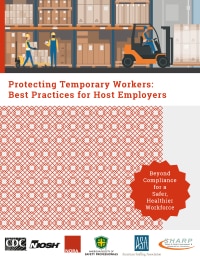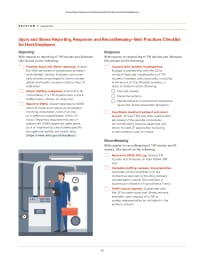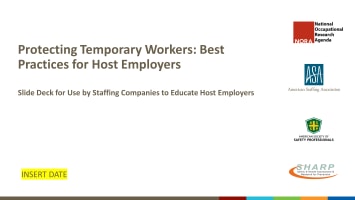Protecting Temporary Workers
Best Practices for Host Employers
Temporary agency workers (hereafter “temporary workers”) are those who are paid by a staffing company and assigned to a host employer [1], including both short- and long-term assignments. Research demonstrates that the risk of experiencing a work-related injury may be higher for temporary workers than for non-temporary workers. i-iii
According to the Occupational Safety and Health Administration (OSHA), host employers are responsible for protecting the safety and health of all workers, whether temporary or permanent.
NIOSH and the National Occupational Research Agenda (NORA) Services Sector Council—in partnership the American Society of Safety Professionals (ASSP), the American Staffing Association (ASA), and the Safety and Health Assessment and Research for Prevention (SHARP) program within the Washington State Department of Labor and Industries—developed a set of best practices to help host employers optimize their efforts to protect the safety and health of temporary workers. The best practices are organized into three sections:
- Evaluation and contracting;
- Training for temporary workers and their worksite supervisors; and
- Injury and illness reporting, response, and recordkeeping.
This document, applicable across industries and occupations, includes real-life scenarios to provide examples of how the recommended practices might be implemented as well as checklists for each of the three sections that can be printed or completed electronically. There is also a slide deck for staffing companies to use to educate their host employer clients about the best practices contained in the document.
Worker safety and health goes hand in hand with worker engagement, productivity, and performance. By following these best practices and going beyond compliance with OSHA laws and regulations, host employers can do their part to ensure a safer, healthier workforce, which may ultimately contribute to an increased competitive advantage.
You can view the release webinar for an overview of the history, development, and contents of the document. We encourage you to share this resource with your networks using the dissemination toolkit, which includes a draft email, a flyer, and social media messages.
Additional information and resources regarding the joint safety and health responsibilities of host employers and staffing companies can be found on the OSHA Temporary Worker Initiative website.
If you have questions or need more information, please contact the NORA Coordinator at NORACoordinator@cdc.gov.
[1] Host employers may also be referred to as worksite employers, clients of staffing companies, or secondary employers.
References
i Al-Tarawneh IS, Wurzelbacher SJ, Bertke SJ [2020]. Comparative analysis of workers’ compensation claims of injury among temporary and permanent employed workers in Ohio. Am J Ind Med 63:3–22.
ii Foley M [2017]. Factors underlying observed injury rate differences between temporary workers and permanent peers. Am J Ind Med 60(10):841–851.
iii Howard J [2017]. Nonstandard work arrangements and worker health and safety. Am J Ind Med 60:1–10.


